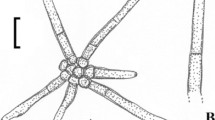Abstract
During a survey of plant-inhabiting fungi in a botanical garden in Japan, some noteworthy fungi were collected from leaf spots of some herbal and arboreal plants. Among them, five new species are described, namely: Phyllosticta. ardisiicola on Ardisia crenata, Phy. aspidistricola on Aspidistra elatior, Phy. kerriae on Kerria japonica, Phy. fallopiae on Fallopia japonica, and Pseudocercospora davidiicola on Davidia involucrata. Passalora pyrrosiae, a new combination for Pseudocercospora pyrrosiae on Pyrrosia lingua, is proposed based on its morphological characteristics designating the neotype specimen.
Similar content being viewed by others
References
Crous PW, Braun U (2003) Mycosphaerella and its anamorphs: 1. Names published in Cercospora and Passalora. Centraalbureau voor Schimmelcultures, Utrecht
Crous PW, Kang JC, Braun U (2001) A phylogenetic redefinition of anamorph genera in Mycosphaerella based on ITS rDNA sequences and morphology. Mycologia 93:1081–1101
Crous PW, Liebenberg MM, Braun U, Groenewald JZ (2006) Re-evaluating the taxonomic status of Phaeoisariopsis griseola, the causal agent of angular leaf spot of bean. Stud Mycol 55:163–173
Den Breeÿen A, Groenewald JZ, Verkley GJM, Crous PW (2006) Morphological and molecular characterization of Mycosphaerellaceae associated with the invasive weed, Chromolaena odorata. Fungal Divers 23:89–110
Horie H, Kobayashi T (1984) Diseases of ornamental woody plants observed at Higashiyama Botanical Park, Nagoya. Trans Jpn For Soc 95:443–444
Hunter GC, Crous PW, Wingfield BD, Pongpanich K, Wingfield MJ (2006) Pseudocercospora flavomarginata sp. nov., from Eucalyptus leaves in Thailand. Fungal Divers 22:71–90
Iwata Y (1957) Phyllosticta aspidistrae Oud. and Macrophoma aspidistrae n. sp. on the leaf of Aspidistra elatior Blume (in Japanese). Ann Phytopathol Soc Jpn 22:164–165
Katsuki S (1953) Notes on parasitic fungi of Yaku-Island. J Jpn Bot 28:279–288
Katsuki S (1955) Parasitic fungi flora of Yaku-Island, Kyusyu. 2. J Jpn Bot 30:370–376
Katsuki S (1965) Cercosporae of Japan. Trans Mycol Soc Jpn (Extra Issue) 1:1–100
Kobayashi T (1973) Notes on new or little-known fungi inhabiting woody plants in Japan. V. Trans Mycol Soc Jpn 14:266–279
Miura M (1928) Flora of Manchuria and East Mongolia. III. Cryptogams, fungi (in Japanese). South Manchuria Railway Co., Dalian, pp 408–426
Motohashi M, Nishikawa J, Akiba M, Nakashima C (2008) Studies on the Japanese species belonging to the genus Phyllosticta (1). Mycoscience 49:11–18
Nakashima C (2001) Taxonomic study of Cercospora and allied genera in Japan. PhD thesis, Tokyo University of Agriculture, Tokyo
Nakashima C, Kobayashi T (1997) Etiological studies on brown spot disease of Pyracantha. Ann Phytopathol Soc Jpn 63:309–315
Okane I, Nakagiri A, Ito T (2001) Identity of Guignardia sp. Inhabiting ericaceous plants. Can J Bot 79:101–109
Okane I, Lumyong S, Nakagiri A, Ito T (2003) Extensive host range of an endophytic fungus Guignardia endophyllicola (anamorph: Phyllosticta capitalensis). Mycoscience 44:353–363
Petrak F (1920) Der mykologische Nachla Josef Jahn’s, ein Beitrag zur Pilzflora des Egerlandes. Ann Mycol 18:105–135
Petrak F (1956) Mykologische Bemerkungen. Sydowia 10:296–305
Saccardo PA (1878) Fungi Veneti novi vel critici, series 7. Michelia 1:133–221
Saccardo PA (1892) Sylloge Fungorum omnium hucusque cognitorum, vol 10. Published by the author, Padua
Saccardo PA, Saccardo D (1906) Sylloge Fungorum omnium hucusque cognitorum, vol 18. Published by the author, Padua
Saccardo PA, Saccardo D, Traverso GB, Trotter A (1931) Sylloge Fungorum omnium Hucusque Cognitorum, vol 25. Published by the author, Abellini
Sawada K (1958) Researches on fungi in Tohoku district of Japan (IV). Fungi Imperfecti (in Japanese). Bull Gov For Exp Stn Tokyo 105:35–140
Spegazzini C (1910) Mycetes argentinenses, Series V. An Mus Nac Hist Nat B Aires 20:329–467
Taylor JE, Groenewald JZ, Crous PW (2003) A phylogenetic analysis of Mycosphaerellaceae leaf spot pathogens of Proteaceae. Mycol Res 107:653–658
van der Aa HA (1973) Studies in Phyllosticta. I. Stud Mycol 5:1–110
van der Aa HA, Vanev S (2002) A revision of the species described in Phyllosticta. Centraalbureau voor Schimmelcultures, Utrecht
Author information
Authors and Affiliations
Corresponding author
About this article
Cite this article
Motohashi, K., Araki, I. & Nakashima, C. Four new species of Phyllosticta, one new species of Pseudocercospora, and one new combination in Passalora from Japan. Mycoscience 49, 138–146 (2008). https://doi.org/10.1007/s10267-007-0395-z
Received:
Accepted:
Published:
Issue Date:
DOI: https://doi.org/10.1007/s10267-007-0395-z




